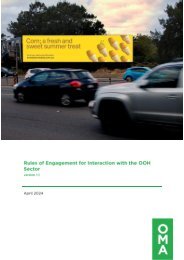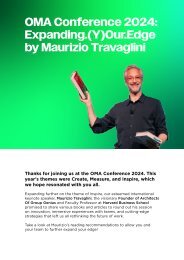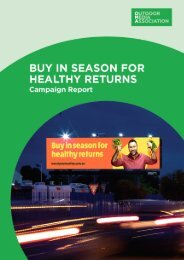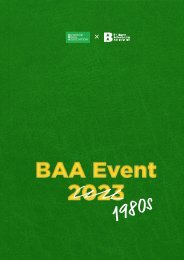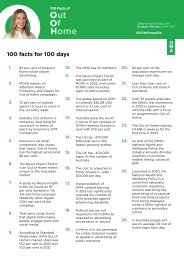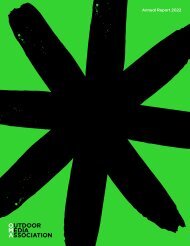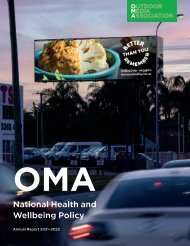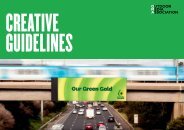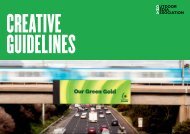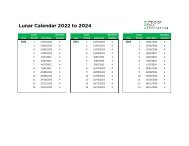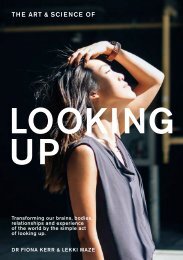OPEN 2
The OPEN series was born from the desire to create a forum for applauding and interrogating strong creative design within the Out of Home (OOH) industry. Illustrating how OOH is part of our cityscape, our commute, our weekend and our shopping and holiday experiences, OOH is ‘the original tweet’ and it cannot be switched off, ignored or fast forwarded. Big, bold, cheeky, simple, clever and controversial, OOH is the ultimate creative stage, allowing brands to be unique, contextually relevant and targeted while reaching mass audiences.
The OPEN series was born from the desire to create a forum for applauding and interrogating strong creative design within the Out of Home (OOH) industry. Illustrating how OOH is part of our cityscape, our commute, our weekend and our shopping and holiday experiences, OOH is ‘the original tweet’ and it cannot be switched off, ignored or fast forwarded. Big, bold, cheeky, simple, clever and controversial, OOH is the ultimate creative stage, allowing brands to be unique, contextually relevant and targeted while reaching mass audiences.
Create successful ePaper yourself
Turn your PDF publications into a flip-book with our unique Google optimized e-Paper software.
TELL ME A STORY<br />
Andy Lark, Founder & Chief Executive Officer,<br />
Group Lark<br />
...<br />
Few start with it. Even fewer end with it.<br />
Most include it – more or less. But rarely<br />
does anyone start with it and let it dominate.<br />
That’s how it’s always been with Out-of-<br />
Home (OOH) advertising.<br />
Some of the most memorable campaigns,<br />
however, launched alongside Australia’s roads,<br />
inside bus shelters and atop our buildings, teach<br />
us that OOH is more than just part of the mix;<br />
a checkbox to tick in effective planning. They<br />
underscore that OOH can be the starting point<br />
– or even the entire platform – for the creative<br />
idea and campaign.<br />
Who can’t recall the roadside image of<br />
the kid’s eyes bleeding in the rain to emphasise<br />
the need for driving safely in the rain? Or,<br />
for us Kiwis, Tui Beer’s now iconic Yeah<br />
right campaign? How about last summer’s<br />
brilliant Bonds’ Boobs billboards? (pp. 20–21)<br />
They all bet big on OOH and won – not just<br />
hearts and minds, but also wallets. Much like<br />
the Commonwealth Bank Can campaign,<br />
Bonds teased the idea of Boobs before the<br />
campaign broke, creating both anticipation and<br />
talkability. OOH wasn’t just part of the mix,<br />
it ignited the mix.<br />
So it was at Commonwealth Bank in<br />
opening the Can campaign. Billboards across<br />
the country created anticipation and planted<br />
the idea firmly in the minds of Australians.<br />
By the time the campaign broke a week later,<br />
Commonwealth Bank owned ‘Can’ and had<br />
provoked a national conversation. OOH had<br />
again proven its effectiveness as a potent<br />
creative platform for reaching consumers.<br />
Today the fight for consumer attention<br />
has never been more intense and difficult to<br />
win. As other traditional media channels dive<br />
in priority in the face of the onslaught of digital,<br />
OOH remains a crucial way to win mindshare.<br />
It has firmly established itself, not just as an<br />
integral part of the mix, but as a pivot point for<br />
driving the success of campaigns. But simply<br />
changing the way we think about using OOH<br />
won’t be enough. We have to re-imagine the<br />
potential of OOH itself.<br />
Three forces are going to make OOH even<br />
more crucial in the years ahead.<br />
First, mobile. What happens on the phone<br />
is less important than what the phone interacts<br />
with. The camera, GPS and accelerometer<br />
are just a few of the technologies driving<br />
interaction. QR codes became one of the first<br />
tools for driving interaction with phones. While<br />
achieving limited popularity here in Australia,<br />
it’s hard to encounter OOH in Hong Kong that<br />
doesn’t feature them.<br />
Like all early technologies, QR codes<br />
were a signal of things to come. Near Field<br />
Communications and iBeam will afford new<br />
opportunities for interaction – for both content<br />
and commerce. Imagine buying what you see<br />
with a simple ‘tap and go.’<br />
Second, data. To date, the majority of<br />
OOH has featured limited interactivity. Most<br />
video has been a rotation of fixed mass-market<br />
messages. Big data coupled with dynamic<br />
presentation will mean OOH gets personal.<br />
Very personal.<br />
So you ‘friended’ your favourite car brand<br />
on Facebook. They’ve captured your photo,<br />
digitised it to create a data fingerprint, and<br />
reconciled your profile with their customer<br />
database. They now know that presenting you<br />
with a new car offer might not be so smart –<br />
you just bought a new car months ago – but<br />
presenting you with insurance, a credit card,<br />
or other services will make much more<br />
sense. So, as you are strolling down the road,<br />
billboards change dynamically.<br />
It’s all very Minority Report. And it’s<br />
here now. Already, digital display systems that<br />
identify consumers individually and then serve<br />
the most relevant ad are being tested across<br />
109 /



